Few Jews were Marine Corps pilots in WWII – Mike Zanger was…!

The story behind the search for Mike Zanger has intrigued me ever since I heard it from his niece, Marcy Hanigan, back in 2011. Like so many stories that came out of WWII, it had a hero’s death, a family’s heartbreak, and the need for closure.
But hers was like no other I’d ever heard because this one also had a level of serendipity that I’ve seldom – if ever – observed:
It all happened because of a passionate researcher who spent over 30 years tracing the death of a fighter pilot, who had crashed in the South Pacific near the end of WWII. And then spent the last 10 years vainly trying to find any of the pilot’s kin who wanted to hear about it.
I met Marcy through a mutual friend, Dr. David Scully, who was eager to have us get together because he knew both of our stories, and now he was determined that we share our own astounding discoveries with each other.
I’ll get to the serendipity part in a moment. But first a little history:
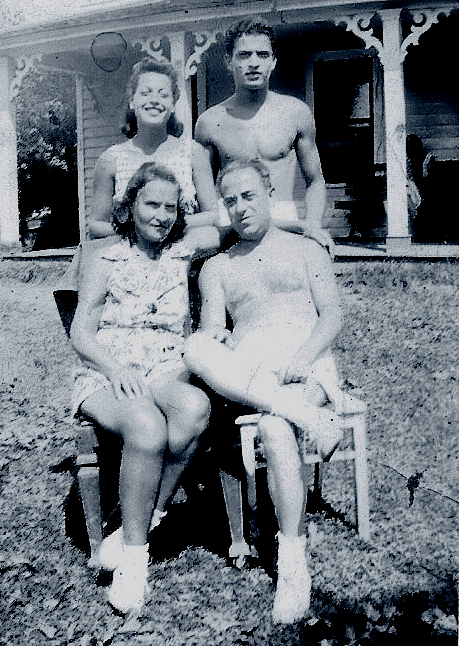
Moszek Zanger was born in 1920 in Grodzisk, Poland. He had two older sisters, Alice and Goldie, or Grace.
Still an infant when his family immigrated to the Bronx, New York, he grew up there and attended college at CCNY.
Now an American, his family and friends called him “Mike” or “Murray”.
Zanger’s middle sister, Grace, was also Marcy’s mother, and was very close to him until he left home and joined the Navy, where he learned to fly before transferring to the Marine Corps, early in WWII.
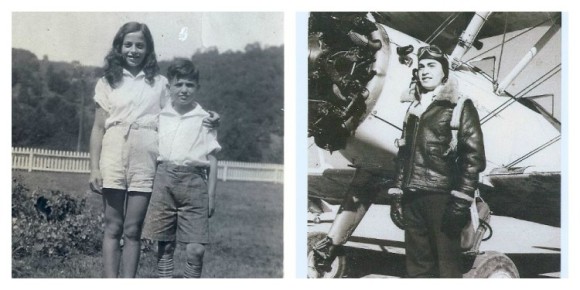
As a U.S. Marine Corps officer, he found himself in a unique position. There were precious few Jewish officers in either the Navy or Marine Corp at the time. And even fewer who were Polish-born fighter pilots. A very rare combination indeed.

In Dec. 1944 Mike’s family was notified that he was M.I.A. Then in Oct. 1945, months after VJ Day, they learned the circumstances of his having to bail out and subsequent capture by the Japanese.
But it wasn’t until March 1946, when they received that tragic news that Mike had been killed trying to escape.
Then, as if that wasn’t devastating enough, the Zangers also learned that their entire family – those who had remained behind in Grodzisk, Poland, had all perished in Treblinka, at the hands of the Nazis.
Grace took all of this tragic news very hard. Hearing the fate of the loved ones she knew as a child in Grodzisk was major blow. But then learning that her dear brother Mike was also dead was traumatic almost beyond her ability to cope.
She said very little about him after that, only confirming that he was shot trying to escape. As a result Marcy and her two sisters, Andrea and Susan, only knew that he was lost in the Pacific and died a prisoner of war. Nothing more.
According to Marcy, Grace was so devastated by the news that she never really recovered. Then, sadly, in 2009, at age 92, she passed away.
Even after her passing, any attempts at closure met with precious little success and the whole Zanger story could have easily ended right there. But Grace’s passing prompted the sisters to investigate what they didn’t know about their family’s Polish-immigrant history on their own.

That’s when events took a serendipitous turn. As they began their research, Marcy’s middle sister, Susan, was asked by her husband, a former Marine and Vietnam vet himself, if she ever knew what happened to her Marine Corps uncle, and was his body ever recovered after the war? Her answer was, “No”.
But with a renewed incentive, Susan did what anyone else would do in the this age of computers. She ran an online search for Moszek Zanger.
What she found and when she found it were absolutely astounding:
Within days after their mother’s passing, on a website called Pacificwrecks.com, Susan discovered a highly detailed report about her uncle. The author was a man by the name of Henry Sakaida, but it was written back in 1997, twelve years earlier.
The website where Susan finally found her uncle’s story had been created in 1995 by Justin Taylan, who had grown up fascinated by his grandfather’s exploits as an Army photographer in the Pacific, during the war.
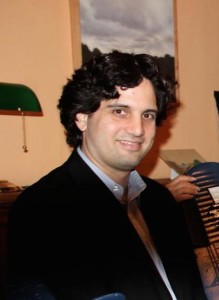
As a result, Justin made numerous trips to many island crash sites, to retrace his grandfather’s wartime footsteps. There he made many discoveries of the details surrounding the remaining relics from the war in the Pacific, which led to the creation of PacificWrecks.com.
People from all over the world have contributed information to it, including veterans, and their relatives, plus historians, travelers, and authors like Henry Sakaida.
Susan soon learned that Sakaida was not just an author and historian, but an avid researcher, with a fascination for the wartime exploits of Japanese pilots, many of whom he had interviewed in person for his numerous books.
So it wasn’t too much of a stretch for him to learn of the existence of Lt. Zanger through a couple of ex-Zero pilots who actually met him while he was a POW. But coming up with all the details took Sakaida another 30 years.
While it took Henry that long to finally find out what happened to Zanger’s body, he also spent ten years vainly searching for any living relatives who might be interested in what he learned.
Sadly, Zanger’s nieces still believed that his remains were lost forever somewhere in the South Pacific. None of them were aware that their uncle was actually buried nearby in another part of Los Angeles, less than 20 miles from Marcy’s house.
The Military had taken his body and had it reinterred at a Jewish Cemetery sometime in 1946.

Through his research, Sakaida already knew where he was buried. But by then he was so determined to share the truth with any one of Zanger’s family that on two occasions he left Post-It notes on Mike’s tombstone — at the Home of Peace Memorial Park in Los Angeles, California.
But it was Andrea, Marcy’s older sister, who was determined to find Sakaida. Not an easy task. However, when she finally traced him to the town of Rosemead, a suburb of Los Angeles, she could only turn up the name of a Nursery, that he had recently sold, but nothing more. Her only alternative was to leave a message for him to call. Happily, it reached Sakaida and two days later he phoned them.
Ironically, after his fruitless ten year search for Zanger’s next of kin, they had tracked him down instead.
As a forensic historian, it was in 1981, when he had been researching information for a new book, “Siege of Rabaul”(1., that Sakaida first heard of an American aviator called “Zanga” from a Japanese pilot who had seen Zanger in captivity.

Hoping to include “the Zanger Incident” in his book, for the next thirty years Sakaida took on the lonely task of requesting military and government documents, pouring over files and papers and interviewing other Japanese pilots.
Researched down to the very last detail, in addition to Zanger’s personal history, he traced his F4U Corsair’s history from the time it was built to its demise, including contract numbers, delivery dates, plus much much more.
Click on the link below and you can see his report for yourself
https://www.pacificwrecks.com/aircraft/fg/14417.html
Here are some highlights…..
After it was built, FG-1 Corsair 14417,(2. was shipped to the Pacific, and designated for the Marine Corps. Then it was flown to Guadalcanal and assigned to the aircraft pool as of October 26, 1944, when it was assigned to squadron VMF-222 “Flying Deuces” and to 1st Lt. Mike Zanger.

On Dec. 5, 1944, Zanger was part of a formation of F4Us that took off on a mission over Rabaul, on the island of New Britain. Near the target, the formation made a left turn over the southern coastline when Zanger and his wing man suffered a mid-air collision. While the other pilot was able to regain control of his damaged Corsair, Zanger’s lost a wing and he had to bailout. He landed without injury near Ataliklikun Bay, but was later captured by the Japanese.
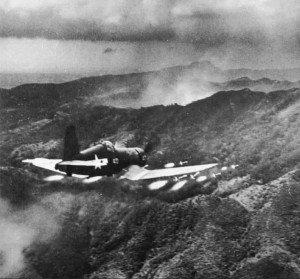
Zanger had a survival pack that included a one-man rubber dinghy. Sakaida believes he inflated it and set off in an attempt to escape. But the raft was painted yellow and easily seen from the shore.
Subsequently captured by a Japanese navy patrol boat, Zanger was imprisoned at Tobera Airfield. He remained there in squalid conditions for roughly 6-7 months, shackled in chains in a hut at the airfield, which was still being bombed and strafed by Allied aircraft.
The F4U Corsair was a powerful and heavily armed fighter plane. When combined with the pilots who flew them, they were a formidable foe for the Japanese airmen, who considered them the toughest and the most highly respected of all their American opponents.
Three Japanese Navy Zero pilots heard that an American Corsair pilot had been recently captured and was now a prisoner. Curious about their enemy, and possibly with the idea of extracting some retribution, the three pilots went to Tobera to see him. But when they met Zanger, all three were so impressed that they never harmed him.
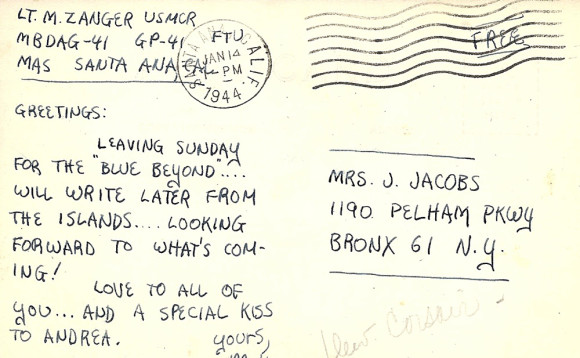
Military reports noted that in late June or July, 1945, Zanger was shot and killed trying to escape captivity. But Sakaida contends that this doesn’t stand up to scrutiny and was more likely a cover story – that he was actually beaten to death.
The Japanese were cruel to their prisoners. So, it’s doubtful that Zanger would have been physically capable of escaping the guards and making a run for it. At the time, his health would have deteriorated badly from his many months in captivity, his malnourishment and no medical treatment.
In the autopsy report that Sakaida discovered, it indicated that Zanger “had lots of fractures and broken bones but NO gunshot wounds, which led him to believe that Zanger was bludgeoned to death – not shot.”
But this is where the story takes an improbable turn. To help the family find closure, Sakaida suggested that he and Zanger’s nieces all take a trip half way around the world to Rabaul, Papua New Guinea, and search for Zanger’s plane. And he would underwrite the adventure.
And so they did in April 2012.

Justin Taylan found the coordinates of the Corsair’s crash site and helped plan the expedition. Familiar with Pacific Islanders and the local etiquette in Papua New Guniea, he suggested the group arrive with items to give the villagers.
“We brought a whole bunch of Frisbees, little toys and candles for the kids,” said Sakaida. “And we asked permission to enter the peoples’ property to search. An earlier governmental group hadn’t and people didn’t like that”
Taylan, Sakaida, and Ray Nishihira, Susan’s husband, were the first to scout the crash site but they were put off by what they found. While part of the plane was visible, it was buried in years of mud, muck, and rainwater, not to mention the swarms of marauding mosquitos that were attacking them. Wisely, they decided to let the site dry out a bit.
But when they returned to the site three days later, this time with the three sisters, they were stunned by what they found.

“Villagers from the settlement of Vudal had cleared a lot of space to work. They also opened up the whole area and put flowers around”, Sakaida said. “There were 20 or 30 adults and 40 schoolkids there to help. Everybody was pitching in.”
Hanigan described them as some of the kindest and most humane people she ever met.
However, to bring total closure to the search and make this trip a success, they had to prove that this was really Mike Zanger’s plane. But this wouldn’t be easy because most Corsairs were built by Vought, while Zanger’s plane was one of the few built by Goodyear. So, it was imperative that they find a Goodyear stamp somewhere on the plane’s wreckage. But they’d have to find a tiny imprint that was smaller than a dime, which made the work both grueling and precise.
In order to illustrate what they were looking for, Andrea took a marking pen and drew the Goodyear logo on her backpack – it was a capital “G” with a smaller capital “A” inside of it.
Hanigan said what happened next was a moment she will never forget: “The documents in Pacific Wrecks said our uncle’s plane had crashed at 2:30 in the afternoon and at exactly 2:30 that afternoon, we found the identifying mark. It was really magical.” (3.
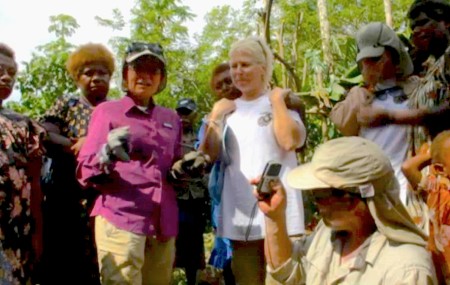
She and her sisters wept at the sight of it and the realization that they were really there, in the presence of their uncle’s plane. Now they were actually touching the pieces he had touched.
According to Hanigan, despite having never met her Uncle, she still felt his presence through the memory of their mother, which in many ways made the journey for her, since she was the one who had been so close to her brother and so devastated by his death.
“I think she would have been moved to tears over this,” she said. “It would have meant so much to her. She would have been real proud of us. I know that.“
So, here they were, half way around the world on a beautiful island in the Pacific, finally finding closure to the real story of their Uncle Mike.

(1. For more information on Henry Sakaida and his books.
(2. FG-1 is the Navy’s ID for the few Goodyear built Corsairs, while F4U was the far more familiar designation for the iconic airplane built by Vought.
(3. Had Zanger’s plane not been one of the very few built by Goodyear, it would have been practically impossible to ID it as his, adding yet another bit of serendipity to the story.


This is my umpteenth reading of your wonderful writing. Thank you for sharing our experience.
And thank you, Andrea, for your very kind words.
Pete,
I finally had time to sit down an read this wonderful discovery story. I wish I had more time to talk with you at Larry’s last Saturday. Hope all is well and please keep these wonderful stories coming!
This is a wonderful story re Marcy’s uncle Mike!
WOW! Wonderful story! Serendipity for sure!